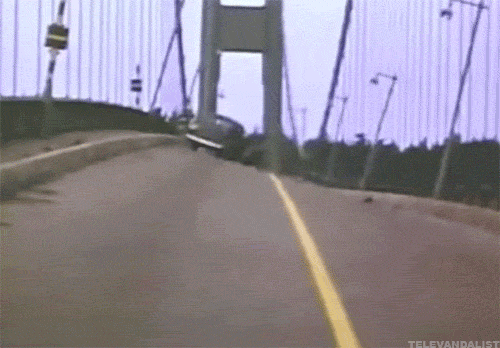
Half an hour earlier, at around 9:30 a.m., authorities had closed the bridge to traffic, just as one last car was making the crossing. Leonard Coatsworth, news editor for the Tacoma News Tribune, was on his way to his family's summer cottage on the peninsula, with Tubby, his daughter's Cocker Spaniel, in the backseat.He quickly realized, Gertie's bounce was much bigger than usual. Just past the midpoint, the undulations sent his car toppling over sideways. He climbed out through the window and immediately hit the concrete face first."My knees were raw and bleeding, my hands bruised and swollen from gripping the concrete curb."



All that remained were two giant towers, a mess of cables, and a conundrum: why did Gertie gallop—and why did she gallop herself to death? "I'm completely at a loss to explain the collapse," the bridge's lead engineer told the Associated Press that night.An article two days later in the New York Times, titled "A Great Bridge Falls," seemed to offer an explanation: "Time successive taps correctly and soon the pendulum swings with its maximum amplitude. So with this bridge. What physicists call resonance was established."One of history's most well-known bridges—and its spectacular collapse, 75 years ago this year—doesn't actually mean what we tend to think it means.

A cartoon from the Seattle Times, November 8, 1940. Via University of Washington Libraries




Photographer Howard Clifford running off the Tacoma Narrows Bridge during collapse. Via University of Washington's Tacoma Narrows Bridge Collection
The flutter / self-excitation explanation was developed by Robert Scanlan, an engineering professor at Johns Hopkins who co-authored a canonical 1991 paper about the event with K. Yusuf Bilah of Princeton. Their findings were reinforced by the research of Daniel Green and William Unruh of the University of British Columbia in a 2004 paper. But even now, the explanation for how the wind caused the bridge to gallop to begin with remains a topic of discussion. "The detailed method through which the oscillatory behaviour is established," they write, "may require some further details."A Positive Feedback Effect (With Negative Effects)If resonance is a wine glass that's been shattered by an opera singer's voice as it vibrates at the glass' natural frequency, self-excitation or flutter is more like an amp that shrieks when it gets too close to its own microphone. This feedback effect is used all the time to great and weird effect in rock music, but the closer you bring a live microphone to its speaker—the louder the audio that's fed into the system and fed back out and fed back in and so on—the closer you'll come to blowing the speaker (and maybe nearby eardrums). The bridge behaved in a similar way that morning. It was stuck in its own loop of self-interaction, feeding its own energy back into itself until it fell apart.If resonance is a wine glass that's been shattered by an opera singer's voice, self-excitation is more like the screech of a speaker that's too close to its own microphone
At a glance of the edited footage, it's tempting to think that Gertie was brought down by resonance, given the vivid visual evidence of a bridge that undulates before it collapses, not unlike the wine glass that shatters under the vibrations of a singer's voice. In fact, resonance is a similar phenomenon to flutter, to the extent that it involves the "reinforcement" of existing oscillations and can lead to a dramatic and possibly destructive amplification of energy.Bilah and Scanlan write that the phenomenon acting on the bridge "would appear not to contradict the qualitative definition of resonance… if we now identify the source of the periodic impulses as self-induced [rather than external], the wind supplying the power, and the motion supplying the power-tapping mechanism." The key term there is self-induced. That is not how forced resonance is typically described (the matching of an external force's oscillations with that of another object), or what is implied when people blame only the force of the wind for the bridge's collapse.But the resonance explanation has persisted, thanks to repeated mistakes by physics teachers and textbook writers and science journalists, and buttressed by the convenience of the video evidence. The bridge's engineers had forgotten many lessons from the early days of suspension bridges. Somehow, the media, teachers, and scientists misremembered the new lessons.very improbable that the resonance with alternating vortices plays an important role in the oscillations of suspension bridges. It was found that there is no sharp correlation between wind velocity and oscillation frequency such as is required in case of resonance with vortices whose frequency depends on the wind velocity.





From the National Register of Historic Places registration form for "Galloping Gertie"




